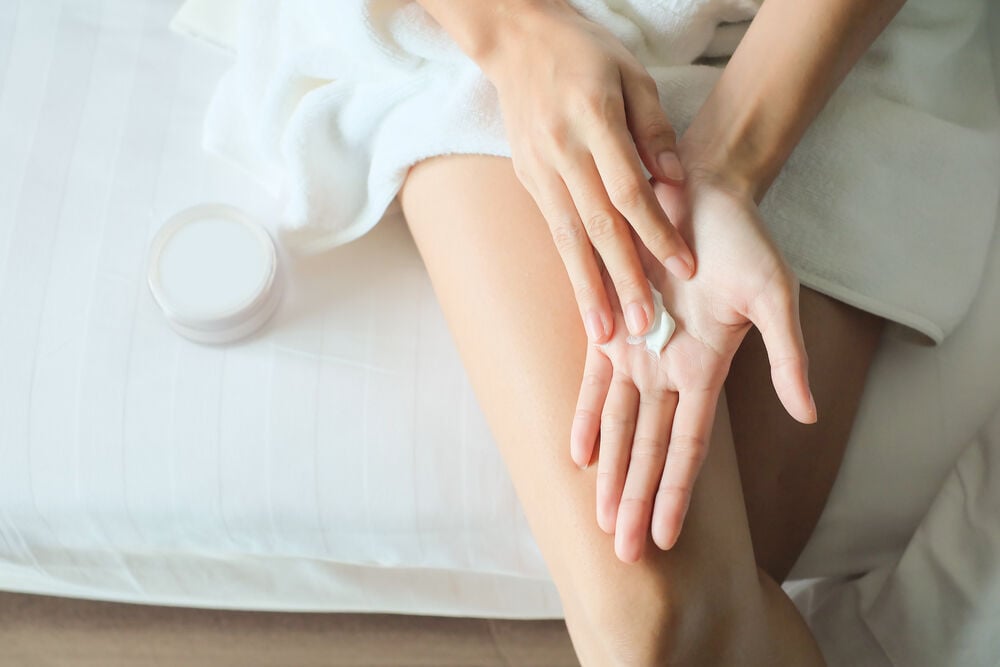When hormones don’t work like they’re supposed to, they can cause a variety of problems. Correcting these hormone levels is tricky and may include treatments that range from dietary changes to surgery. Another potential treatment for hormonal issues is a vaginal estrogen cream. Read on to discover how it works, how to use it, and any side effects you should watch out for.
-
Tracking cycle
-
Getting pregnant
-
Pregnancy
-
Help Center
-
Flo for Partners
-
Anonymous Mode
-
Flo app reviews
-
Flo Premium New
-
Secret Chats New
-
Symptom Checker New
-
Your cycle
-
Health 360°
-
Getting pregnant
-
Pregnancy
-
Being a mom
-
LGBTQ+
-
Quizzes
-
Ovulation calculator
-
hCG calculator
-
Pregnancy test calculator
-
Menstrual cycle calculator
-
Period calculator
-
Implantation calculator
-
Pregnancy weeks to months calculator
-
Pregnancy due date calculator
-
IVF and FET due date calculator
-
Due date calculator by ultrasound
-
Medical Affairs
-
Science & Research
-
Pass It On Project New
-
Privacy Portal
-
Press Center
-
Flo Accuracy
-
Careers
-
Contact Us
Vaginal Estrogen Cream: Why and How to Use It


Every piece of content at Flo Health adheres to the highest editorial standards for language, style, and medical accuracy. To learn what we do to deliver the best health and lifestyle insights to you, check out our content review principles.
Why use vaginal estrogen cream?
There are many different treatments for symptoms of menopause and low estrogen available today. You could change your diet or lifestyle or even supplement with different products.
Women who are going through menopause experience a dramatic shift in their hormones. As the hormones change and stop monthly periods, they can also create some unpleasant vaginal symptoms, such as:
- Vaginal dryness
- Vaginal itching
- Vaginal burning
- Pain during sex due to lack of natural vaginal lubrication
- Painful urination
- Difficulties urinating
- Sudden and frequent need to urinate
Hormones affect vaginal health. During menopause, these same hormones shift, changing vaginal health as well.
Vaginal estrogen cream is used to treat the above-mentioned symptoms, as well as others. It should only be used as prescribed by your doctor. If you have any of the above symptoms and are going through menopause, talk to your doctor. They may want to run a few tests before prescribing a vaginal cream to help alleviate these symptoms.
How to use vaginal estrogen cream

If you’re going through menopause and experiencing some of the discomforts of a hormonal imbalance, estrogen cream can help alleviate some of those symptoms.
Vaginal cream is designed to be used inside your vagina. It can be used right at the vaginal opening or inserted deeper inside.
Take a quiz
Find out what you can do with our Health Assistant
To use vaginal estrogen cream, you need to be able to insert it into your vaginal canal. Follow these steps to get your applicator filled with the correct dosage:
- Wash your hands thoroughly with soap and warm water.
- Remove the cap from the tube of vaginal cream.
- Screw the nozzle part of the applicator onto the open end of the tube.
- Find the correct dosage. The applicator has markings on it that indicate how much cream will be inserted. Your doctor will give you the dosage amount they want you to use.
- Gently squeeze the tube so the cream fills the applicator to the required dosage mark.
- Unscrew the applicator from the tube, replace the cap on the tube, and set the tube aside.
Now that your applicator is filled and ready for use, you can insert it. You will be inserting the applicator tip into your vagina, so give yourself a few minutes of privacy and either wear easy-access clothing like a robe or remove your clothing. You will need to be in a room where you can lie down on your back.
How to insert the applicator:
- Lie on your back.
- Pull your knees up toward your chest.
- Gently insert the applicator into your vagina.
- Press the plunger to release the dosage of estrogen cream.
- Remove the applicator from your vagina.
You need to clean your applicator after each use. Simply pull the plunger to remove it from the applicator barrel. Use mild soap and warm water to clean the applicator barrel and plunger. Don’t use hot water or boil the applicator.
Estrogen cream benefits
There are many benefits to using estrogen cream. If you use vaginal cream with the correct dosage, it can alleviate many symptoms of menopause, such as:
- Vulvovaginal atrophy, which includes dryness, itching, burning, and atrophic vulvovaginitis — When estrogen levels drop during menopause, it can cause the vaginal area to become less lubricated, dry, thin, and atrophic. Estrogen increases the production of normal lubrication. When your estrogen level drops, your glands stop producing natural lubricants, potentially causing your vaginal area to become dry. This can also cause itching and a burning sensation because your tissues are now more sensitive to fabric, friction, and urination. Vaginal pH increases make your vaginal walls more prone to inflammation.
- Painful intercourse — When hormone levels change, they can make it difficult to become aroused during sex. Coupled with vaginal dryness and loss of vaginal wall elasticity, this can make intercourse painful and frustrating.
- Urinary problems — The lower urinary tract is directly affected by estrogen. Estrogen receptors are found in the urethral and bladder epithelial lining, as well as in some of the surrounding muscles and ligaments. That is why low estrogen levels can result in urinary problems such as increased frequency, urgency, incontinence, dysuria, and urinary tract infections.
Vaginal estrogen cream can make menopause much more comfortable. As your hormone levels even out, you may find that you can stop using the cream. In fact, prolonged use of vaginal cream can produce some negative side effects. Be sure to follow your doctor’s orders, and let them know when your symptoms change.
Estrogen cream side effects
Because estrogen cream is a form of hormone treatment, it has the same possible side effects as other hormone treatments.
The hormones in our bodies are in a constant balancing act. Simple things like changes in diet can throw them off. If you’re taking estrogen cream for a particular ailment, it can help balance your hormones. But if you use it for too long or use too much at a time, you can put your hormones out of balance again.
The main complications of estrogen therapy are deep vein thrombosis, pulmonary embolism, coronary heart disease, and endometrial and breast cancer. But the low dose of estrogen in local vaginal creams helps to avoid these complications. Low-dose estrogen cream may still cause some side effects such as:
- Breast pain/tenderness
- Nausea/heartburn
- Dizziness
- Vomiting
- Depression
- Anxiety
- Leg cramps
- Vaginal discharge
- Hair loss/unwanted hair growth
- Back pain
- Cold or flu symptoms
- Difficulty sleeping
Some side effects are more serious than others. If you experience any of the following side effects, contact your doctor immediately:
- Bulging eyes
- Yellowing skin
- Movements that are difficult to control
- Joint pain
- Hives
- Swelling in the face or extremities
- Difficulty breathing
Keep your doctor informed about your symptoms, and let them know how well the estrogen cream is working. Let them know when you have changes in your symptoms. They’ll give you a dosage limit and a time frame for using the vaginal cream when you receive your prescription. If your symptoms change, your doctor can change the dosage to ensure you aren’t putting too much estrogen into your system.

Track symptoms and patterns
Learn to spot patterns in your cycle as they can provide insight into underlying medical conditions
Bottom line
Menopause can be challenging. Hormones control a lot of bodily functions, and when they start shifting, the whole body can experience changes.
For more unpleasant symptoms of vulvovaginal atrophy, a vaginal estrogen cream can help alleviate pain and discomfort. Because it’s a hormone-based treatment, it’s important to stick to your doctor’s dosage. Keep your doctor informed when your symptoms change. They’ll keep a close eye on your symptoms. If you start to experience side effects, your doctor can reduce or stop your treatments.


Hey, I'm Anique
I started using Flo app to track my period and ovulation because we wanted to have a baby.


The Flo app helped me learn about my body and spot ovulation signs during our conception journey.


I vividly
remember the day
that we switched
Flo into
Pregnancy Mode — it was
such a special
moment.
Real stories, real results
Learn how the Flo app became an amazing cheerleader for us on our conception journey.




